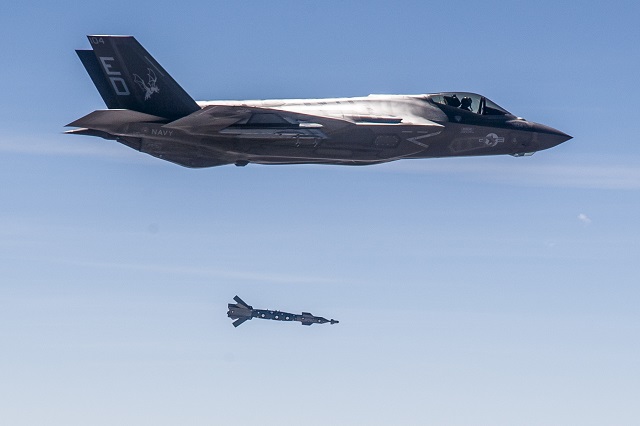|
|
|||
 A GBU-12 Paveway II guided bomb is about to strike a computer-driven small pickup truck during a test at Naval Air Weapons Station China Lake, California. The inert bomb was dropped from an Edwards F-35C. (Image courtesy of Lockheed Martin) A GBU-12 Paveway II guided bomb is about to strike a computer-driven small pickup truck during a test at Naval Air Weapons Station China Lake, California. The inert bomb was dropped from an Edwards F-35C. (Image courtesy of Lockheed Martin) |
|||
|
|
|||
|
“This was really a test of the aircraft targeting system and associated weaponeering logic, and the results of this test will be used to certify this capability with a GBU-12 on the F-35.
The weaponeering logic is all the information compiled to give the pilot that one solution. “(The pilot) doesn’t have to think about how fast the target’s going, or what direction,” O’Fallon said. “By him using this 3F capability, it’s doing all the weaponeering for him. That’s really the big thing, it’s a single-seat fighter. He’s got to do it all, so we want to do as much for him as we can.” Although the GBU-12 was inert, it still made short work of its intended target, a small pickup truck. O’Fallon said the decision was that the target vehicle would be towed on a 60-foot trailer by an existing remote controlled tow vehicle in the interest of saving time and money. The tow vehicle was not controlled in real time, but rather the route was recorded via GPS and the controlling computer drove this route maintaining a sterile exclusion zone. “It’s pretty cool. The guy gets in, hits the record button. He drives the route we want. Then he hits save and the vehicle will reset itself to its initial start point,” said O'Fallon. The whole point of the autonomous tow vehicle was safety, making sure nobody’s in the hazard zone. “Nobody has to be in there making last-minute adjustments,” O’Fallon said. According to O’Fallon, the data collected from this test will certify this weapon capability and enhance the lethality of the F-35. "This test is also the first developmental test release of a guided GBU-12 from the F-35C model." Developmental testing here has now performed a GBU-12 release from every F-35 variant. |
|||
F-35C targeting system guides GBU-12 Paveway II Laser-Guided Bomb to moving target
- Posted On











